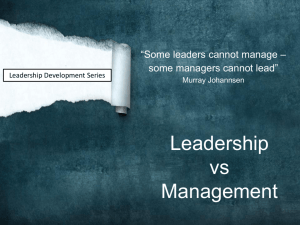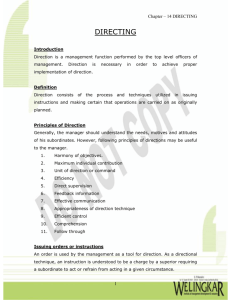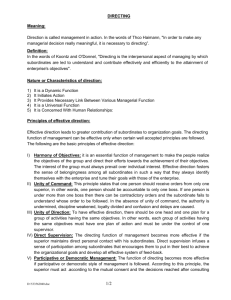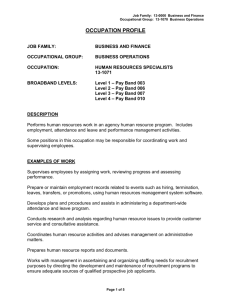(1)
advertisement
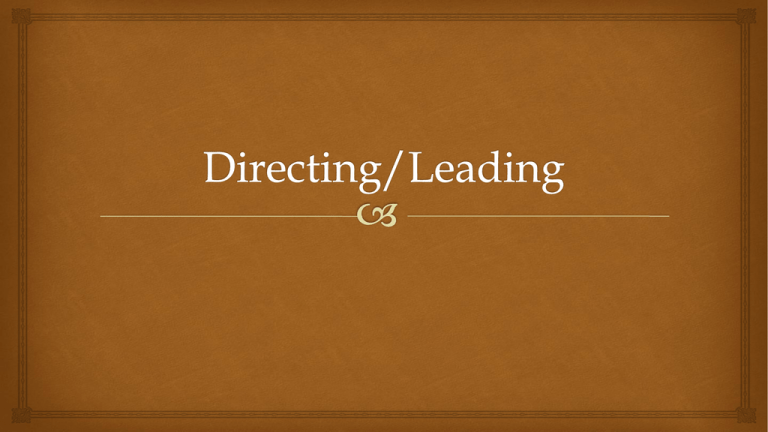
Directing: Function of Management DIRECTING is said to be a process in which the managers instruct, guide and oversee the performance of the workers to achieve predetermined goals. DIRECTING is said to be the heart of management process. Planning, organizing and staffing have got no importance if direction function does not take place. DIRECTING initiates action and it is from here actual work starts. Direction is said to be consisting of human factors. In simple words, it can be described as providing guidance to workers is doing work. Characteristics of Directing Pervasive Function - Directing is required at all levels of organization. Every manager provides guidance and inspiration to his subordinates. Continuous Activity - Direction is a continuous activity as it continuous throughout the life of organization. Human Factor - Directing function is related to subordinates and therefore it is related to human factor. Since human factor is complex and behavior is unpredictable, direction function becomes important. Characteristics of Directing Creative Activity - Direction function helps in converting plans into performance. Without this function, people become inactive and physical resources are meaningless. Executive Function - Direction function is carried out by all managers and executives at all levels throughout the working of an enterprise, a subordinate receives instructions from his superior only. Delegate Function - Direction is supposed to be a function dealing with human beings. Importance of Directing Directing or Direction function is said to be the heart of management of process and therefore, is the central point around which accomplishment of goals take place. A few philosophers call Direction as “Life spark of an enterprise”. Benefits It Initiates Actions - Directions is the function which is the starting point of the work performance of subordinates. subordinates understand their jobs and do according to the instructions laid. It Ingrates Efforts - Through direction, the superiors are able to guide, inspire and instruct the subordinates to work. For this, efforts of every individual towards accomplishment of goals are required. Means of Motivation - A manager makes use of the element of motivation here to improve the performances of subordinates. This can be done by providing incentives or compensation, whether monetary or non monetary, which serves as a “Morale booster” to the subordinates. Benefits It Provides Stability - Stability and balance in concern becomes very important for long term sun survival in the market. Stability is very important since that is an index of growth of an enterprise. Coping up with the changes - It is a human behavior that human beings show resistance to change. Adaptability with changing environment helps in sustaining planned growth and becoming a market leader. It is directing function which is of use to meet with changes in environment, both internal as external. Efficient Utilization of Resources - Direction finance helps in clarifying the role of every subordinate towards his work. The resources can be utilized properly only when less of wastages, duplication of efforts, overlapping of performances, etc. doesn’t take place. 4 Elements of Directing (1) Supervision: It refers to monitor the progress of routine work of one’s subordinates and guiding them properly. Supervision has an important feature that face-to-face contact between the supervisor and his subordinate is a must. 4 Elements of Directing (2) Communication: It refers to an art of transferring facts, ideas, feeling, etc. from one person to another and making him understand them. A manager has to continuously tell his subordinates about what to do, how to do, and when to do various things. 4 Elements of Directing (3) Leadership: It refers to influence others in a manner to do what the leader wants them to do. Leadership plays an important role in directing. Only through this quality, a manager can inculcate trust and zeal among his subordinates. 4 Elements of Directing (4) Motivation: It refers to that process which excites people to work for attainment of the desired objective. Among the various factors of production, it is only the human factor which is dynamic and provides mobility to other physical resources. 8 Most Important Principles of Directing (1) Principle of Maximum Individual Contribution: According to this principle, management should adopt that directing policy through which the employees get motivated and give their maximum individual contribution for the achievement of organizational objective. (2) Principle of Harmony of Objectives: According to this principle, there must be full coordination between organizational and individual objectives. Employees work in an organization with an objective to get better remuneration, promotion, etc. On the other hand, organizational goal can be to earn more profits and to increase market share. Management here must establish coordination between the objectives of both the parties/factors by adopting 8 Most Important Principles of Directing (3) Principle of Unity of Command: According to this principle, a subordinate should get directions from one officer at a time. If the subordinate gets directions from more than one officer, the subordinate will be unable to priorities his work. (4) Principle of Appropriateness of Direction Technique: According to this principle, appropriate direction techniques should be used, e.g., to supervise effectively, to provide able leadership, to adopt free communication and to motivate through right medium. 8 Most Important Principles of Directing (5) Principle of Managerial Communication: According to this principle, it should be monitored by the management that the subordinates get the same meaning for what has been said. This simplifies the job of the subordinates and they need not go to the managers repeatedly for enquiring. (6) Principle of Use of Informal Organization: According to this principle, there must be a free flow of information between the seniors and the subordinates. The success of direction depends upon effective exchange of information to a great extent. 8 Most Important Principles of Directing (7) Principle of Leadership: According to this principle, while giving directions to the subordinates a good leadership must be provided by the managers. By this, subordinates get influenced by the managers. In this situation, subordinates act according to the wish of the managers. (8) Principle of Follow Through: According to this principle, it must be monitored by management as to what extent the policies framed and issued directions have been enforced. Thus, it must be seen whether the employees are following the management or not. If yes, then to what extent. As per this principle, the job of managers is not to sit idle after framing policies or issuing directions but to continuously take feedback. The advantage of this will be that if there is any problem in implementing a policy or a direction it can be removed then and there. Motivation motivation actually describes the level of desire employees feel to perform, regardless of the level of happiness. How to motivate employees There are many ways to motivate employees. Managers who want to encourage productivity should work to ensure that employees: Feel that the work they do has meaning or importance Believe that good work is rewarded Believe that they are treated fairly All of these tasks fall under one or more motivational theories. Vroom’s Expectancy theory Expectancy theory outlines the connection employees expect between effort and reward. If an employee does very well and puts forth additional effort, they will likely expect to be rewarded accordingly. Employees who do not feel rewarded become unmotivated. M=E*I*V M (motivation) is the amount a person will be motivated by the situation they find themselves in. E (expectancy) = The person's perception that effort will result in performance. I (instrumentality) = The person's perception that performance will be rewarded/punished. V(valence) = The perceived strength of the reward or punishment that will result from the performance. If the reward is small, the motivation will be small, even if expectancy and instrumentality are both perfect (high). Equity theory Equity theory indicates that employees are best motivated when they feel that they are being treated equally. If two employees perform the same job, and believe that they do so equally well, they would expect equal pay and equal recognition. Lack of equity, whether real or imagined, can damage employee motivation. Again, imagine you are working as hard as you can and find that someone else who works at the same level doing the same job makes more money. Would you want to continue to work as hard? Maslow’s Hierarchy of Needs Theory According to Maslow, lower needs take priority. They must be fulfilled before the others are activated. There is some basic common sense here -it's pointless to worry about whether a given color looks good on you when you are dying of starvation, or being threatened with your life. There are some basic things that take precedence over all else. example Need Home Job self-actualization education, religion, hobbies, personal growth training, advancement, growth, creativity esteem approval of family, friends, community recognition, high status, responsibilities belongingness family, friends, clubs teams, depts, coworkers, clients, supervisors, subordinates safety freedom from war, poison, violence work safety, job security, health insurance physiological Food , water Heat, air, base salary Alderfer's ERG theory This is very similar to Maslow -- can be seen as just collapsing into three tiers. But maybe a bit more rational. Alderfer believed that as you start satisfying higher needs, they become more intense (e.g., the power you get the more you want power), like an addiction. mcclellan’s Acquired Needs Theory Again similar to maslow and alderfer. These needs can be measured using the TAT (thematic apperception test), which is a projection-style test based on interpreting stories that people tell about a set of pictures. Cognitive Evaluation Theory This theory suggests that there are actually two motivation systems: intrinsic and extrinsic that correspond to two kinds of motivators: intrinsic motivators: Achievement, responsibility and competence. motivators that come from the actual performance of the task or job -- the intrinsic interest of the work. extrinsic: pay, promotion, feedback, working conditions -things that come from a person's environment, controlled by others. Frederick Herzberg’s Motivation-Hygiene Theory two kinds of factors affect motivation hygiene factors. These are factors whose absence motivates, but whose presence has no perceived effect. They are things that when you take them away, people become dissatisfied and act to get them back. motivators. These are factors whose presence motivates. Their absence does not cause any particular dissatisfaction, it just fails to motivate. Examples are all the things at the top of the Maslow hierarchy, and the intrinsic motivators. So hygiene factors determine dissatisfaction, and motivators determine satisfaction. The two scales are independent, and you can be high on both. Skinner’s Reinforcement Theory Operant conditioning is the term used by b.f. skinner to describe the effects of the consequences of a particular behavior on the future occurrence of that behavior. Positive reinforcement. This is the process of getting goodies as a consequence of a behavior. You make a sale, you get a commission. You do a good job, you get a bonus & a promotion. Negative reinforcement. This is the process of having a stressor taken away as a consequence of a behavior. Long-term sanctions are removed from countries when Skinner’s Reinforcement Theory Extinction. This is the process of getting no goodies when do a behavior. So if person does extra effort, but gets no thanks for it, they stop doing it. Punishment. This is the process of getting a punishment as a consequence of a behavior. Both Positive and Negative Reinforcement strengthen behavior while both Punishment and Extinction weaken behavior. Douglas McGregor’s Theory X and Theory Y Theory X is pessimistic, static, and rigid. In contrast, Theory Y is optimistic, dynamic, and flexible, with an emphasis on self-direction and the integration of individual needs with organizational demands. Under the assumptions of Theory x Employees inherently do not like work and whenever possible, will attempt to avoid it. Because employees dislike work, they have to be forced, coerced or threatened with punishment to achieve goals. Employees avoid responsibilities and do not work fill formal directions are issued. Most workers place a greater importance on security over all other factors and display little ambition. Under the assumptions of theory y Physical and mental effort at work is as natural as rest or play. People do exercise self-control and self-direction and if they are committed to those goals. Average human beings are willing to take responsibility and exercise imagination, ingenuity and creativity in solving the problems of the organization. That the way the things are organized, the average human being’s brainpower is only partly used. Theory X vs Theory Y Porter and lawler model Suggests that levels of motivation are based more on the value that individuals place on the reward. The components that effect motivation then, are called valence (what's important to you) and expectancy (can you do it). Porter and Lawler suggest that perceived inequality in this model plays a pivotal role in job satisfaction. Motivation or effort leads to performance. This performance is followed by intrinsic and extrinsic rewards. The perceived equity of those rewards leads to satisfaction. Porter and Lawler’s motivation model Value of rewards Ability to do a specified task Perceived Equitable rewards Intrinsic rewards Satisfaction Performance accomplishment Effort Extrinsic rewards Perception of task required Perceived effort and reward probability Adapted from L. W. Porter and E. E. Lawler, Managerial Attitudes and Performance (Homewood, IL: Richard D. Irwin, Inc., 1968), p. 165. Goal Setting Theory of Edwin Locke Planning Actions Implementation States that when the goals to be achieved are set at a higher standard, employees are motivated to perform better and put in maximum effort. Objective setting for motivation Setting objectives Control and Appraisal Credits: Prepared by: EMG20 – C1; Group 1; 1st QTR S.Y. 2014-2015 Alvarez, Carlos Marcelo A. Angeles, John Heider G. Aycocho, Voltaire N. Bacud, Paul Nathaniel M. Balneg, Christine C. Lecture Copyright: Prof. E.S. BIO
